Measuring Location Dominance Based on Public Service Accessibility: Case Study of Shijiazhuang, China
Abstract
1. Introduction
2. Location Dominance
2.1. What Is Location Dominance?
2.2. How Does It Work?
3. Methodology
3.1. Study Area
3.2. Evaluation System
3.2.1. Public Services
3.2.2. Weight Calculation Method
3.3. Measuring Accessibility
3.4. Measuring Location Dominance
3.5. Quantifying the Equality of Location Dominance
4. Results
4.1. Spatial Patterns of Location Dominance
4.2. Correlations Between the Results and Urban Development Factors
5. Discussion and Conclusions
5.1. Spatial Disparities in Public Service Accessibility in Shijiazhuang
5.2. Validation of Location Dominance for Public Service Accessibility Assessment
5.3. Characteristics of the Method in Terms of Granularity, Universality and Practicability
Supplementary Materials
Author Contributions
Funding
Data Availability Statement
Conflicts of Interest
References
- Elmqvist, T.; Bai, X.; Frantzeskaki, N.; Griffith, C.; Maddox, D.; McPhearson, T.; Parnell, S.; Romero-Lankao, P.; Simon, D.; Watkins, M. Urban Planet: Knowledge Towards Sustainable Cities; Cambridge University Press: Cambridge, UK, 2018. [Google Scholar]
- Department of Economic and Social Affairs, Population Division, Population Division. World Urbanization Prospects: The 2018 Revision. Available online: https://population.un.org/wup (accessed on 5 January 2025).
- Huang, K.; Li, X.; Liu, X.; Seto, K.C. Projecting global urban land expansion and heat island intensification through 2050. Environ. Res. Lett. 2019, 14, 114037. [Google Scholar] [CrossRef]
- Sampson, R.J. Urban sustainability in an age of enduring inequalities: Advancing theory and ecometrics for the 21st-century city. Proc. Natl. Acad. Sci. USA 2017, 114, 8957–8962. [Google Scholar] [CrossRef] [PubMed]
- Pandey, B.; Brelsford, C.; Seto, K.C. Infrastructure inequality is a characteristic of urbanization. Proc. Natl. Acad. Sci. USA 2022, 119, e2119890119. [Google Scholar] [CrossRef] [PubMed]
- Liu, R.; Chen, Y.; Wu, J.; Xu, T.; Gao, L.; Zhao, X. Mapping spatial accessibility of public transportation network in an urban area–A case study of Shanghai Hongqiao Transportation Hub. Transp. Res. Part D Transp. Environ. 2018, 59, 478–495. [Google Scholar] [CrossRef]
- United Nations. Transforming Our World: The 2030 Agenda for Sustainable Development. 2015. Available online: https://sdgs.un.org/2030agenda (accessed on 5 January 2025).
- Wu, F.; Zhang, F. Rethinking China’s urban governance: The role of the state in neighbourhoods, cities and regions. Prog. Hum. Geogr. 2022, 46, 775–797. [Google Scholar] [CrossRef]
- Xu, R.; Yue, W.; Wei, F.; Yang, G.; Chen, Y.; Pan, K. Inequality of public facilities between urban and rural areas and its driving factors in ten cities of China. Sci. Rep. 2022, 12, 13244. [Google Scholar] [CrossRef]
- Zhang, W.; Zhang, X.; Wu, G. The network governance of urban renewal: A comparative analysis of two cities in China. Land Use Policy 2021, 106, 105448. [Google Scholar] [CrossRef]
- Li, X.; Hui, E.C.; Chen, T.; Lang, W.; Guo, Y. From Habitat III to the new urbanization agenda in China: Seeing through the practices of the “three old renewals” in Guangzhou. Land Use Policy 2019, 81, 513–522. [Google Scholar] [CrossRef]
- Guangdong Province Old Town Old Factory Old Village Recreation Association; Policy and Legal Professional Committee of Guangdong Province Old Town Old Factory Building and Old Village Recreation Association; Guangdong Huaxian Runke Law Firm, Lvfang Lvdi Institute. Guangdong Province “Three Old Renewal” (Urban Renewal) Policy Compilation (2022 Edition); Guangdong Province Old Town Old Factory Old Village Recreation Association: Guangzhou, China, 2022. [Google Scholar]
- Xi, J. Hold high the great banner of socialism with Chinese characteristics and strive in unity to build a modern socialist country in all respects. In Proceedings of the 20th National Congress of the Communist Party of China, Beijing, China, 16 October 2022. [Google Scholar]
- Cervero, R.; Murphy, S.; Ferrell, C.; Goguts, N.; Tsai, Y.H.; Arrington, G.B.; Boroski, J.; Smith-Heimer, J.; Golem, R.; Peninger, P.; et al. Transit-Oriented Development in the United States: Experiences, Challenges, and Prospects; Transportation Research Board: Washington, DC, USA, 2004. [Google Scholar]
- Yu, Z.; Zhu, X.; Liu, X. Characterizing metro stations via urban function: Thematic evidence from transit-oriented development (TOD) in Hong Kong. J. Transp. Geogr. 2022, 99, 103299. [Google Scholar] [CrossRef]
- Curtis, C.; Scheurer, J. Planning for sustainable accessibility: Developing tools to aid discussion and decision-making. Prog. Plan. 2010, 74, 53–106. [Google Scholar] [CrossRef]
- Lang, W.; Hui, E.C.; Chen, T.; Li, X. Understanding livable dense urban form for social activities in transit-oriented development through human-scale measurements. Habitat Int. 2020, 104, 102238. [Google Scholar] [CrossRef]
- Verachtert, E.; Mayeres, I.; Vermeiren, K.; Van der Meulen, M.; Vanhulsel, M.; Vanderstraeten, G.; Loris, I.; Mertens, G.; Engelen, G.; Poelmans, L. Mapping regional accessibility of public transport and services in support of spatial planning: A case study in Flanders. Land Use Policy 2023, 133, 106873. [Google Scholar] [CrossRef]
- Zeng, C.; Song, Y.; Cai, D.; Hu, P.; Cui, H.; Yang, J.; Zhang, H. Exploration on the spatial spillover effect of infrastructure network on urbanization: A case study in Wuhan urban agglomeration. Sustain. Cities Soc. 2019, 47, 101476. [Google Scholar] [CrossRef]
- Vale, D.S.; Viana, C.M.; Pereira, M. The extended node-place model at the local scale: Evaluating the integration of land use and transport for Lisbon’s subway network. J. Transp. Geogr. 2018, 69, 282–293. [Google Scholar] [CrossRef]
- Xu, W.; Yang, L. Evaluating the urban land use plan with transit accessibility. Sustain. Cities Soc. 2019, 45, 474–485. [Google Scholar] [CrossRef]
- Ramirez, J. Residential Location Theories and Planning: A General Analysis with Special Reference to Latin America. Master’s Thesis, University of Glasgow, Scotland, UK, 1976. [Google Scholar]
- Bathelt, H.; Glückler, J. Toward a relational economic geography. In Economy: Critical Essays in Human Geography; Routledge: London, UK, 2008. [Google Scholar]
- Dunning, J.H.; Lundan, S.M. Multinational Enterprises and the Global Economy, 2nd ed.; Edward Elgar: Cheltenham, UK; Northampton, MA, USA, 2008. [Google Scholar]
- Kalfadellis, P. Location advantages and repeat investment in Australia: A two-state comparison. Reg. Stud. 2015, 49, 1140–1159. [Google Scholar] [CrossRef]
- Cuervo-Cazurra, Á.; de Holan, P.M.; Sanz, L. Location advantage: Emergent and guided co-evolutions. J. Bus. Res. 2014, 67, 508–515. [Google Scholar] [CrossRef]
- Yang, Y.; Mao, Z. Location advantages of lodging properties: A comparison between hotels and Airbnb units in an urban environment. Ann. Tour. Res. 2020, 81, 102861. [Google Scholar] [CrossRef]
- le Duc, N.; Gammeltoft, P. The role of R&D resource commitment in accessing co-location advantages. J. Int. Manag. 2023, 29, 101015. [Google Scholar] [CrossRef]
- Jin, F.; Wang, C.; Li, X.; Wang, J. China’s regional transport dominance: Density, proximity, and accessibility. J. Geogr. Sci. 2010, 20, 295–309. [Google Scholar] [CrossRef]
- Wang, Z.; Fan, H.; Wang, D.; Xing, T.; Wang, D.; Guo, Q.; Xiu, L. Spatial pattern of highway transport dominance in Qinghai-Tibet Plateau at the county scale. ISPRS Int. J. Geo. Inf. 2021, 10, 304. [Google Scholar] [CrossRef]
- Kompil, M.; Jacobs-Crisioni, C.; Dijkstra, L.; Lavalle, C. Mapping accessibility to generic services in Europe: A market-potential based approach. Sustain. Cities Soc. 2019, 47, 101372. [Google Scholar] [CrossRef]
- Basak, I.; Saaty, T. Group decision making using the analytic hierarchy process. Math. Comput. Model. 1993, 17, 101–109. [Google Scholar] [CrossRef]
- Saaty, T.L. A scaling method for priorities in hierarchical structures. J. Math. Psychol. 1977, 15, 234–281. [Google Scholar] [CrossRef]
- Al-Aomar, R. A combined ahp-entropy method for deriving subjective and objective criteria weights. Int. J. Ind. Eng. 2010, 17, 12–24. [Google Scholar]
- Shannon, C.E. A mathematical theory of communication. Bell Syst. Tech. J. 1948, 27, 379–423. [Google Scholar] [CrossRef]
- Xu, S.; Xu, D.; Liu, L. Construction of regional informatization ecological environment based on the entropy weight modified AHP hierarchy model. Sustain. Comput. Inform. Syst. 2019, 22, 26–31. [Google Scholar] [CrossRef]
- Hansen, W.G. How accessibility shapes land use. J. Am. Inst. Plan. 1959, 25, 73–76. [Google Scholar] [CrossRef]
- Páez, A.; Scott, D.M.; Morency, C. Measuring accessibility: Positive and normative implementations of various accessibility indicators. J. Transp. Geogr. 2012, 25, 141–153. [Google Scholar] [CrossRef]
- Handy, S. Is accessibility an idea whose time has finally come? Transp. Res. Part D Transp. Environ. 2020, 83, 102319. [Google Scholar] [CrossRef]
- Levinson, D.; Wu, H. Towards a general theory of access. J. Transp. Land Use 2020, 13, 129–158. [Google Scholar] [CrossRef]
- Chen, Z.; Li, Y.; Wang, P. Transportation accessibility and regional growth in the Greater Bay Area of China. Transp. Res. Part D Transp. Environ. 2020, 86, 102453. [Google Scholar] [CrossRef]
- CJJ 37-2012; Code for Design of Urban Road Engineering. MOHURD: Beijing, China, 2012.
- Delbosc, A.; Currie, G. Using Lorenz curves to assess public transport equity. J. Transp. Geogr. 2011, 19, 1252–1259. [Google Scholar] [CrossRef]
- Tahmasbi, B.; Mansourianfar, M.H.; Haghshenas, H.; Kim, I. Multimodal accessibility-based equity assessment of urban public facilities distribution. Sustain. Cities Soc. 2019, 49, 101633. [Google Scholar] [CrossRef]
- Martin, A.J.F.; Conway, T.M. Using the Gini Index to quantify urban green inequality: A systematic review and recommended reporting standards. Landsc. Urban Plan. 2025, 254, 105231. [Google Scholar] [CrossRef]
- Shirmohammadli, A.; Louen, C.; Vallée, D. Exploring mobility equity in a society undergoing changes in travel behavior: A case study of Aachen, Germany. Transp. Policy 2016, 46, 32–39. [Google Scholar] [CrossRef]
- Bennett, M.M.; Smith, L.C. Advances in using multitemporal night-time lights satellite imagery to detect, estimate, and monitor socioeconomic dynamics. Remote Sens. Environ. 2017, 192, 176–197. [Google Scholar] [CrossRef]
- Levin, N.; Kyba, C.C.; Zhang, Q.; de Miguel, A.S.; Román, M.O.; Li, X.; Portnov, B.A.; Molthan, A.L.; Jechow, A.; Miller, S.D.; et al. Remote sensing of night lights: A review and an outlook for the future. Remote Sens. Environ. 2020, 237, 111443. [Google Scholar] [CrossRef]
- Erb, K.H. How a socio-ecological metabolism approach can help to advance our understanding of changes in land-use intensity. Ecol. Econ. 2012, 76, 8–14. [Google Scholar] [CrossRef]
- Wellmann, T.; Haase, D.; Knapp, S.; Salbach, C.; Selsam, P.; Lausch, A. Urban land use intensity assessment: The potential of spatio-temporal spectral traits with remote sensing. Ecol. Indic. 2018, 85, 190–203. [Google Scholar] [CrossRef]
- Xia, C.; Yeh, A.G.O.; Zhang, A. Analyzing spatial relationships between urban land use intensity and urban vitality at street block level: A case study of five Chinese megacities. Landsc. Urban Plan. 2020, 193, 103669. [Google Scholar] [CrossRef]
- Xu, F.; Wang, Z.; Chi, G.; Zhang, Z. The impacts of population and agglomeration development on land use intensity: New evidence behind urbanization in China. Land Use Policy 2020, 95, 104639. [Google Scholar] [CrossRef]
- Ellis, E.C.; Ramankutty, N. Putting people in the map: Anthropogenic biomes of the world. Front. Ecol. Environ. 2008, 6, 439–447. [Google Scholar] [CrossRef]
- Erb, K.H.; Fetzel, T.; Haberl, H.; Kastner, T.; Kroisleitner, C.; Lauk, C.; Niedertscheider, M.; Plutzar, C. Beyond inputs and outputs: Opening the black-box of land-use intensity. In Social Ecology: Society-Nature Relations Across Time and Space; Springer Nature: Cham, Switzerland, 2016; pp. 93–124. [Google Scholar] [CrossRef]
- Chan, K.W.; Zhang, L. The hukou system and rural-urban migration in China: Processes and changes. China Q. 1999, 160, 818–855. [Google Scholar] [CrossRef]
- Qi, W.; Abel, G.J.; Liu, S. Geographic transformation of China’s internal population migration from 1995 to 2015: Insights from the migration centerline. Appl. Geogr. 2021, 135, 102564. [Google Scholar] [CrossRef]
- Nicoletti, L.; Sirenko, M.; Verma, T. Disadvantaged communities have lower access to urban infrastructure. Environ. Plan. B Urban Anal. City Sci. 2023, 50, 831–849. [Google Scholar] [CrossRef]
- Fu, L. A strategic plan and current situation analysis of public transit in Shijiazhuang City. Qinghai Transp. Sci. Technol. 2018, 10–18. [Google Scholar]
- Rosas-Satizábal, D.; Guzman, L.A.; Oviedo, D. Cycling diversity, accessibility, and equality: An analysis of cycling commuting in Bogotá. Transp. Res. Part D Transp. Environ. 2020, 88, 102562. [Google Scholar] [CrossRef]
- Giuffrida, N.; Pilla, F.; Carroll, P. The social sustainability of cycling: Assessing equity in the accessibility of bike-sharing services. J. Transp. Geogr. 2023, 106, 103490. [Google Scholar] [CrossRef]
- Li, A.; Huang, Y.; Axhausen, K.W. An approach to imputing destination activities for inclusion in measures of bicycle accessibility. J. Transp. Geogr. 2020, 82, 102566. [Google Scholar] [CrossRef]
- Schepers, J.P.; Fishman, E.; den Hertog, P.; Wolt, K.K.; Schwab, A.L. The safety of electrically assisted bicycles compared to classic bicycles. Accid. Anal. Prev. 2014, 73, 174–180. [Google Scholar] [CrossRef] [PubMed]
- Tjahjono, T.; Kusuma, A.; Septiawan, A. The greater Jakarta area commuters travelling pattern. Transp. Res. Procedia 2020, 47, 585–592. [Google Scholar] [CrossRef]
- Ayuriany, T.; Lee, J.; Hidayati, I. What access-for-all entails? Examining commuting experiences from subjective and objective accessibility in a fast-growing city, Jakarta. Asian Transp. Stud. 2023, 9, 100115. [Google Scholar] [CrossRef]
- Jin, T.; Wang, K.; Xin, Y.; Shi, J.; Hong, Y.; Witlox, F. Is a 15-minute city within reach? measuring multimodal accessibility and carbon footprint in 12 major american cities. Land Use Policy 2024, 142, 107180. [Google Scholar] [CrossRef]
- Chin, K.; Huang, H.; Horn, C.; Kasanicky, I.; Weibel, R. Inferring fine-grained transport modes from mobile phone cellular signaling data. Comput. Environ. Urban Syst. 2019, 77, 101348. [Google Scholar] [CrossRef]
- Hadachi, A.; Pourmoradnasseri, M.; Khoshkhah, K. Unveiling large-scale commuting patterns based on mobile phone cellular network data. J. Transp. Geogr. 2020, 89, 102871. [Google Scholar] [CrossRef]
- Mouratidis, K. Time to challenge the 15-minute city: Seven pitfalls for sustainability, equity, livability, and spatial analysis. Cities 2024, 153, 105274. [Google Scholar] [CrossRef]
- Papadopoulos, E.; Sdoukopoulos, A.; Politis, I. Measuring compliance with the 15-minute city concept: State-of-the-art, major components and further requirements. Sustain. Cities Soc. 2023, 99, 104875. [Google Scholar] [CrossRef]
- Chen, B.Y.; Fu, C.; Wang, D.; Jia, T.; Gong, J. How Retailer hierarchy shapes food accessibility: A case study using machine learning method to delineate service areas and hierarchical levels of food retailers. Ann. Assoc. Am. Geogr. 2024, 114, 611–632. [Google Scholar] [CrossRef]
- Bruno, M.; Melo, H.P.M.; Campanelli, B.; Loreto, V. A universal framework for inclusive 15-minute cities. Nat. Cities 2024, 1, 633–641. [Google Scholar] [CrossRef]
- Elvidge, C.D.; Ghosh, T.; Hsu, F.-C.; Zhizhin, M.; Bazilian, M. The Dimming of Lights in China during the COVID-19 Pandemic. Remote Sens. 2020, 12, 2851. [Google Scholar] [CrossRef]
- Jiang, W.; He, G.; Long, T.; Guo, H.; Yin, R.; Leng, W.; Liu, H.; Wang, G. Potentiality of Using Luojia 1-01 Nighttime Light Imagery to Investigate Artificial Light Pollution. Sensors 2018, 18, 2900. [Google Scholar] [CrossRef] [PubMed]
- Shi, K.; Chang, Z.; Chen, Z.; Wu, J.; Yu, B. Identifying and evaluating poverty using multisource remote sensing and point of interest (POI) data: A case study of Chongqing, China. J. Clean. Prod. 2020, 255, 120245. [Google Scholar] [CrossRef]
- Zhou, Y.; Smith, S.J.; Elvidge, C.D.; Zhao, K.; Thomson, A.; Imhoff, M. A cluster-based method to map urban area from DMSP/OLS nightlights. Remote Sens. Environ. 2014, 147, 173–185. [Google Scholar] [CrossRef]

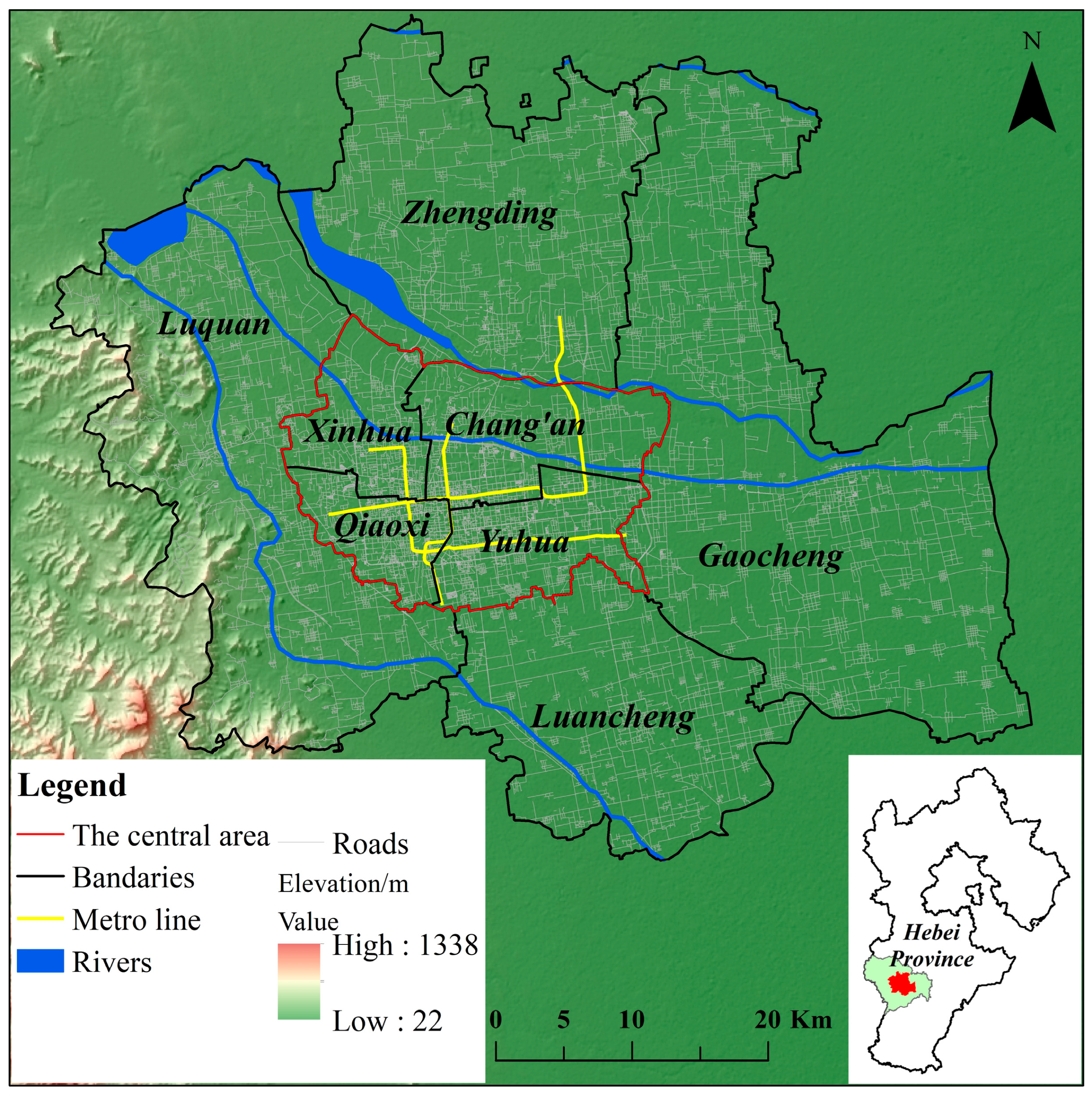
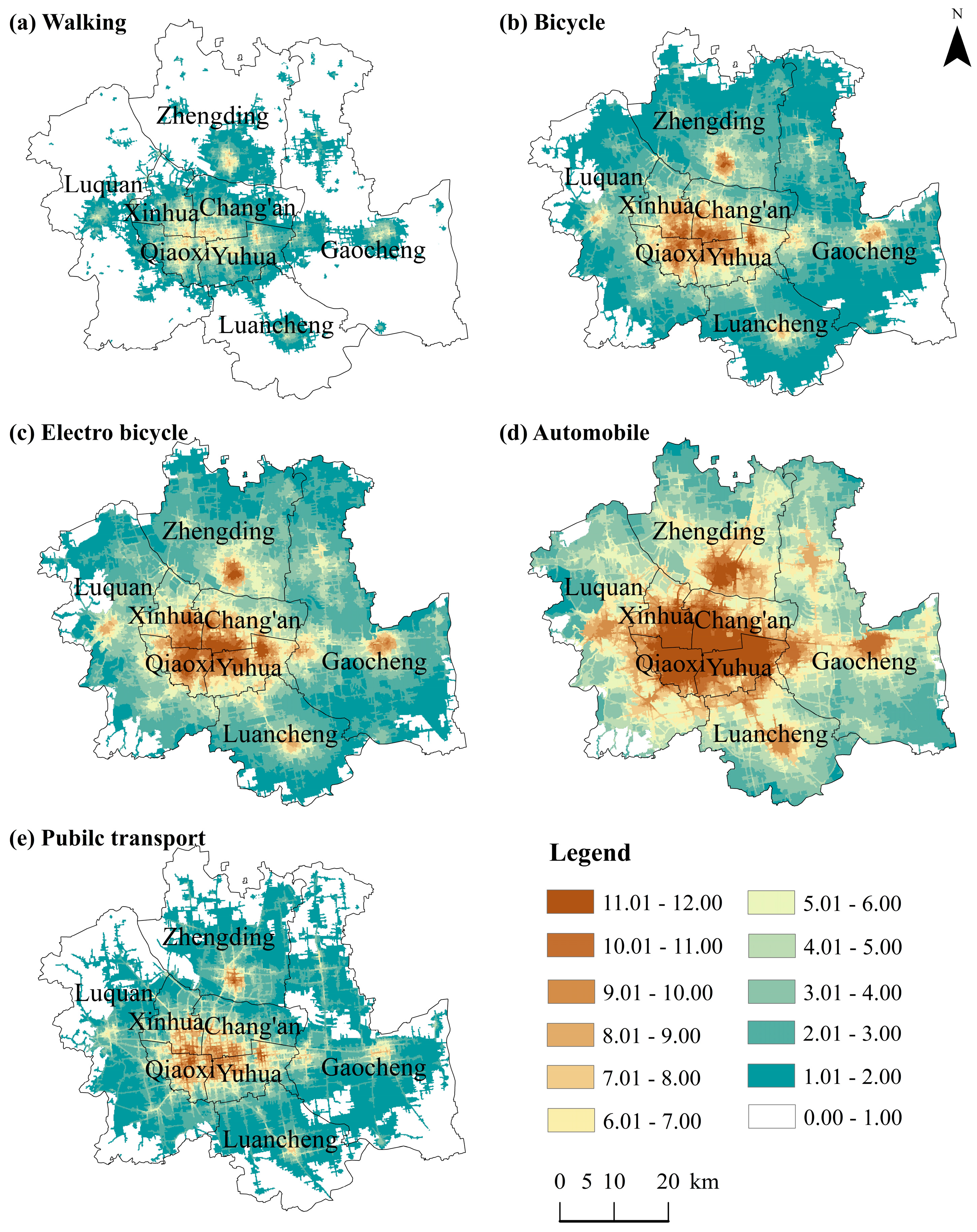
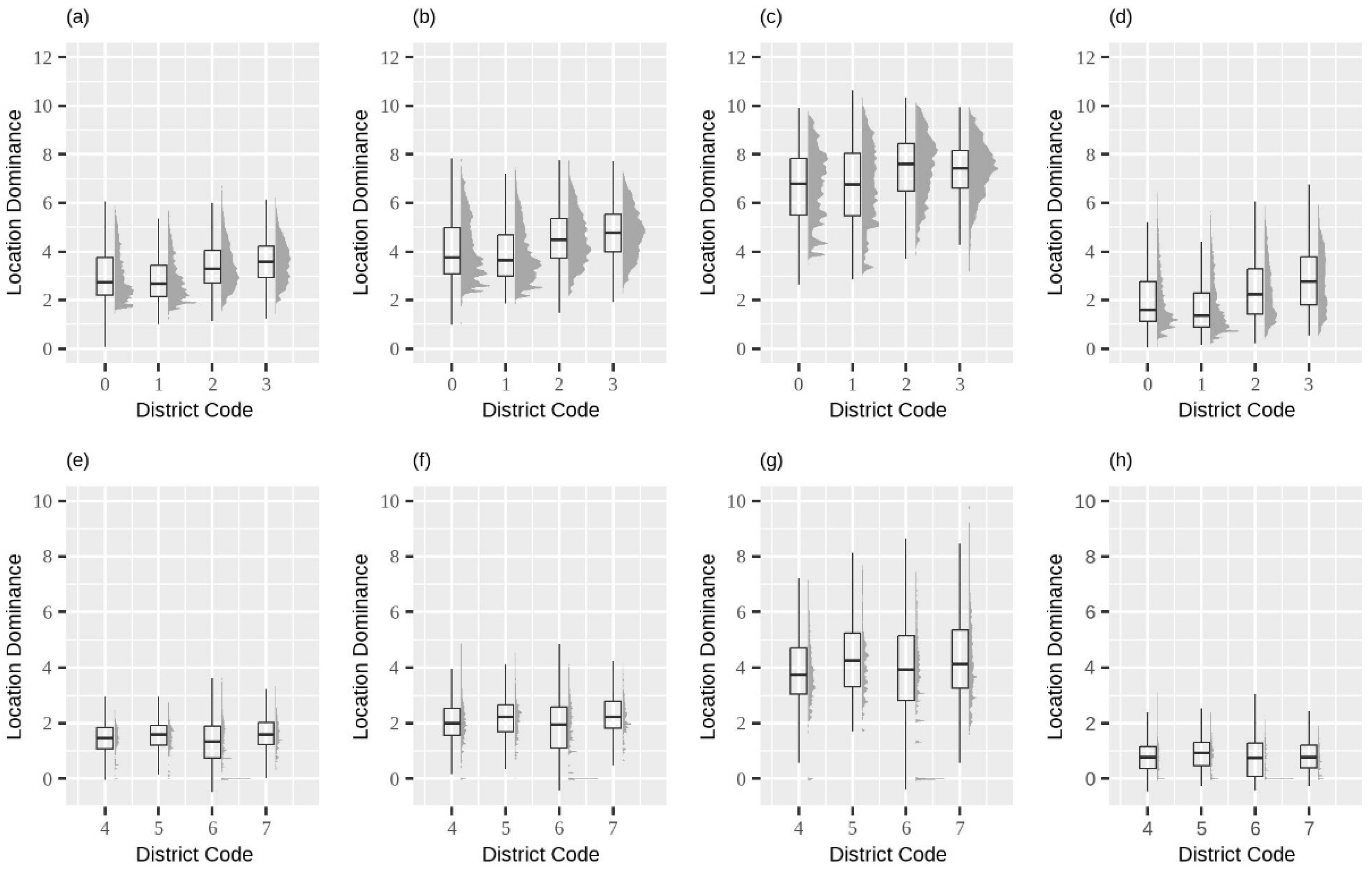
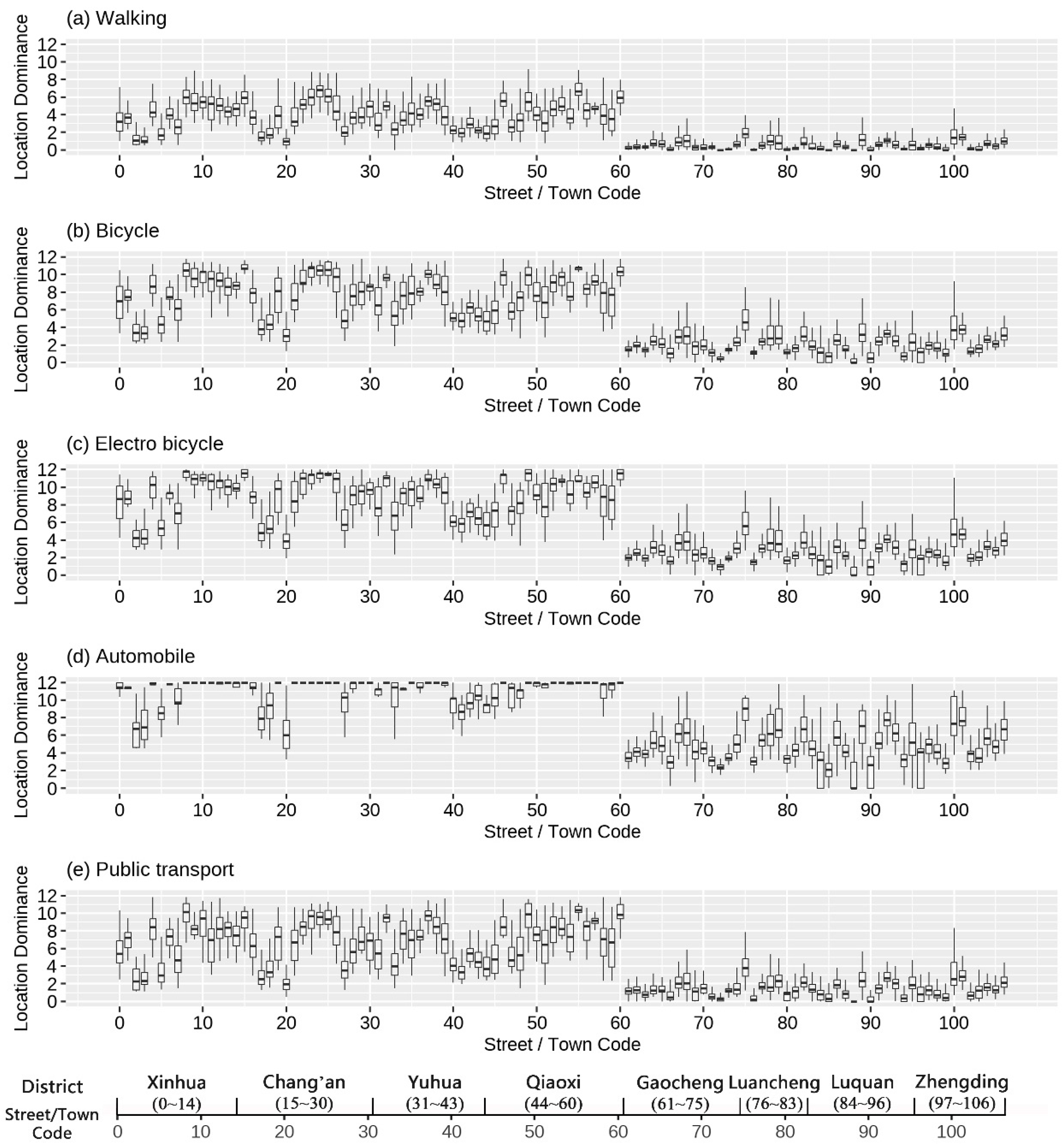
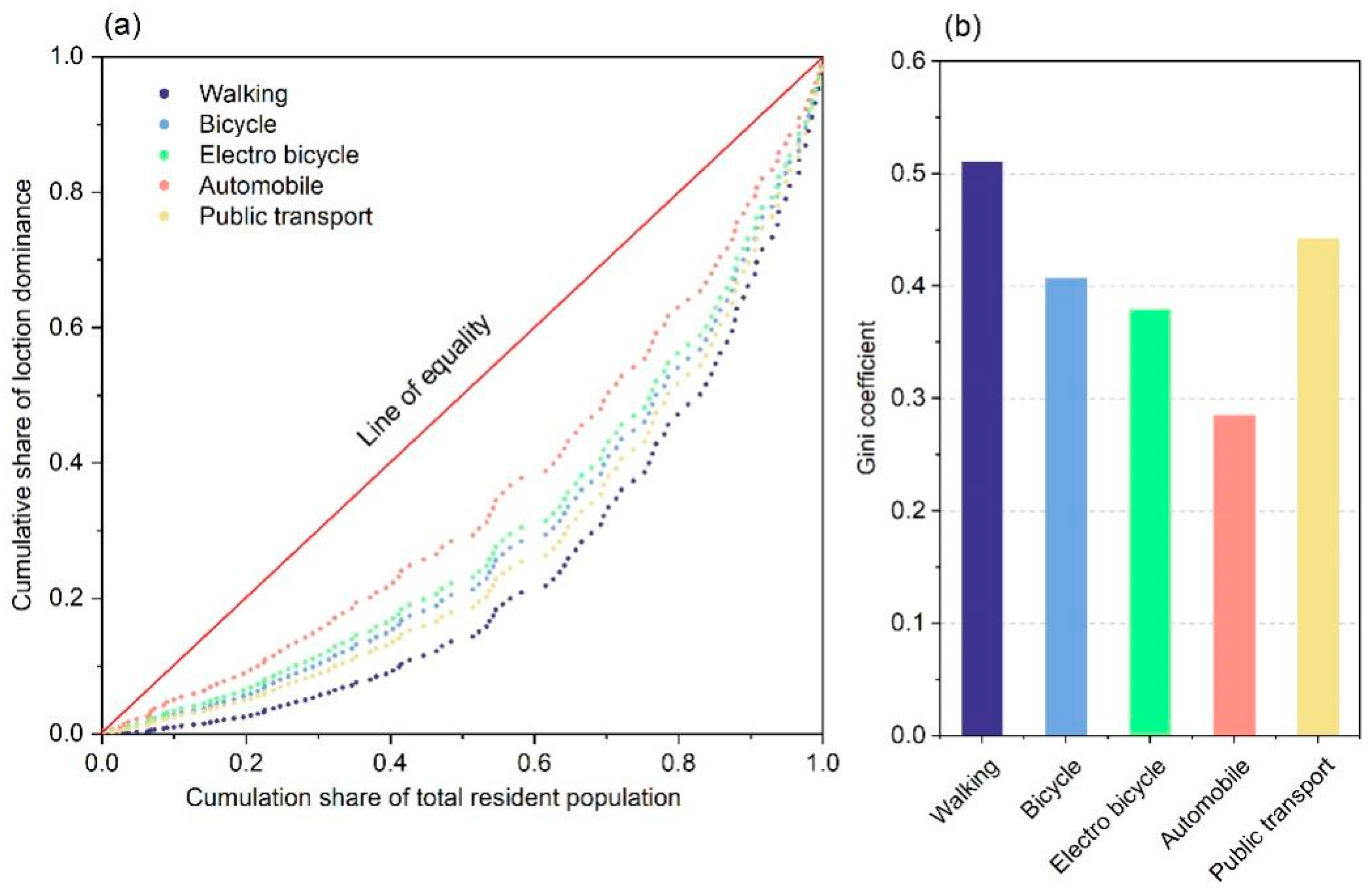

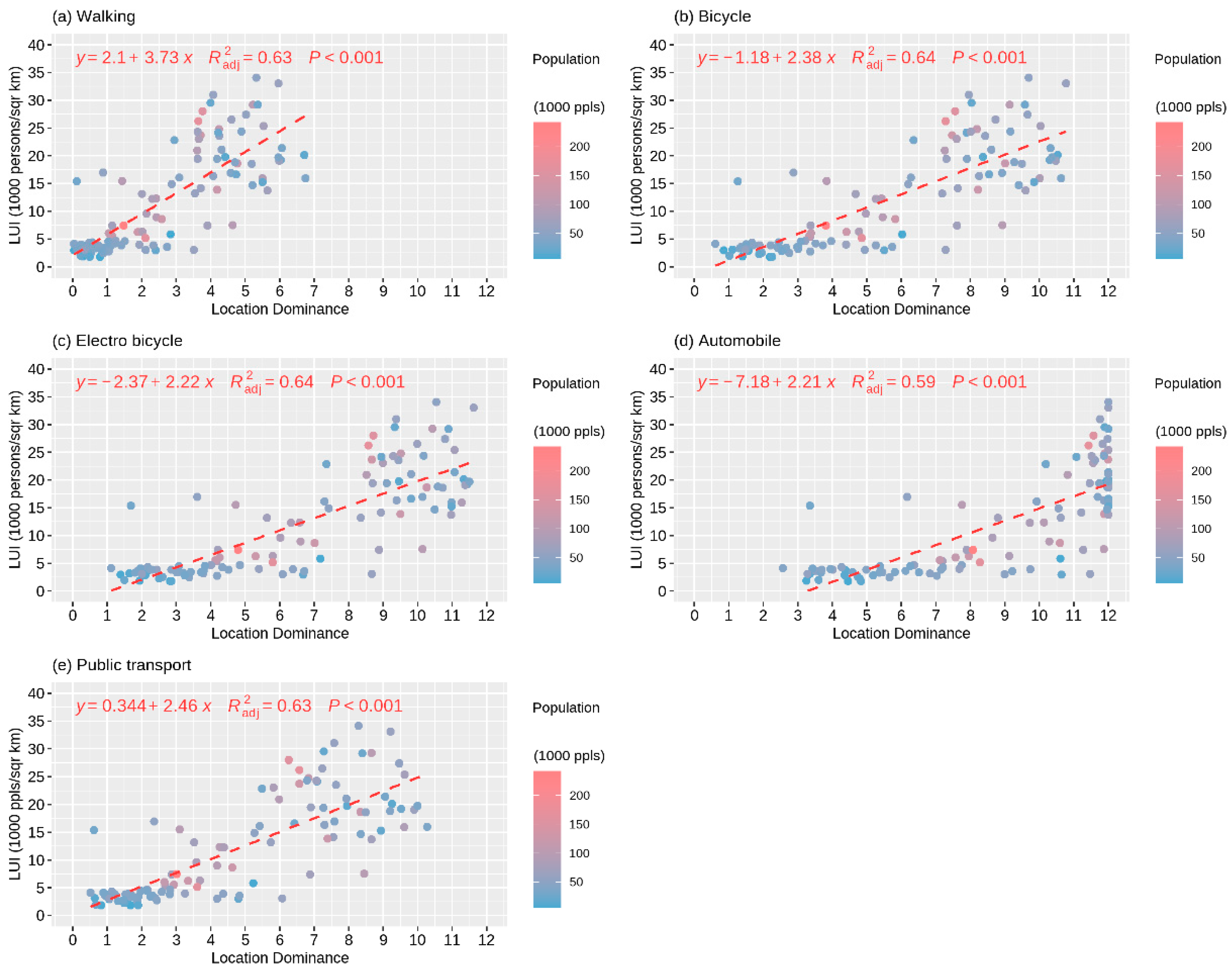
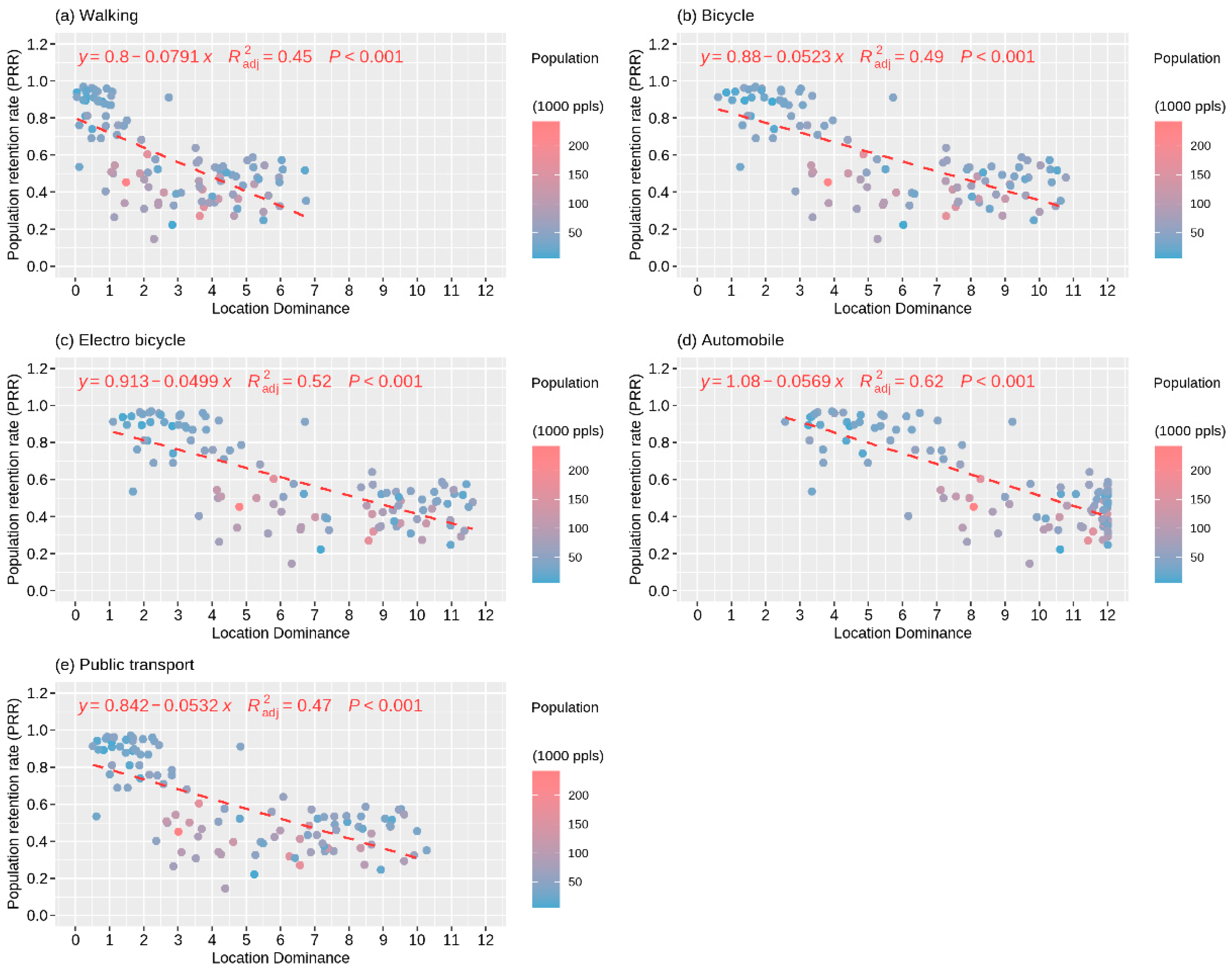
| Types | Subtypes | Count | Code |
|---|---|---|---|
| Medical and Educational Facilities | |||
| Medical facilities | Top-tier comprehensive hospitals | 18 | |
| Other comprehensive hospitals | 103 | ||
| Educational facilities | Kindergartens | 74 | |
| Primary schools | 73 | ||
| Middle schools | 88 | ||
| Leisure and consumption facilities | |||
| Shopping | Shopping Centers | 89 | |
| Home Appliances/Digital Products Markets, Home Furnishing/Building Materials Markets | 64 | ||
| Food and beverage | Supermarkets | 62 | |
| Chinese Restaurants, Foreign Restaurants, Cafeterias, Barbecue Restaurants | 441 | ||
| Snacks, Fast Food, Cake/Dessert Shops | 255 | ||
| Sports and fitness | Sports Venue/Stadium, Extreme Sports Facility/Park, Fitness Center/Health Club, Others | 445 | |
| Cultural facilities | Libraries, Museums, Cultural Palaces, Art Galleries/Museums, Science and Technology Museums/Science Centers, Exhibition Halls/Museums, Historical Sites/Monuments, Cinemas/Movie Theaters, Concert Halls, Theaters | 442 | |
| Ecological scenic facilities | |||
| Parks, Scenic Areas, Botanical Gardens, Zoos, Tourist Attractions | 182 | ||
| Travel Modes | Alternative Roads |
|---|---|
| Walking | Trunk Way, Primary Road, Secondary Road, Tertiary Road, and others |
| Bicycle | Trunk Way, Primary Road, Secondary Road, Tertiary Road, and others |
| Electric bicycle | Trunk Way, Primary Road, Secondary Road, Tertiary Road, and others |
| Automobile | Expressway, Trunk Road, Primary Road, Secondary Road, Tertiary Road, and others |
| Public transport and walking | Metro Route, Bus Route, Trunk Way, Primary Road, Secondary Road, Tertiary Road, and others |
| Road Degree | Traffic Speed (km/h) | Alternative Travel Modes |
|---|---|---|
| Expressway | 80 | Automobile |
| Trunk road | 5.32/15/20/60 | Walking/Bicycle/Electric bicycle/Automobile |
| Primary road | 5.32/15/20/60 | Walking/Bicycle/Electric bicycle/Automobile |
| Secondary road | 5.32/15/20/40 | Walking/Bicycle/Electric bicycle/Automobile |
| Tertiary road and others | 5.32/15/20/30 | Walking/Bicycle/Electric bicycle/Automobile |
| Metro route | 60 | Metro |
| Bus route | 20 | Bus |
Disclaimer/Publisher’s Note: The statements, opinions and data contained in all publications are solely those of the individual author(s) and contributor(s) and not of MDPI and/or the editor(s). MDPI and/or the editor(s) disclaim responsibility for any injury to people or property resulting from any ideas, methods, instructions or products referred to in the content. |
© 2025 by the authors. Licensee MDPI, Basel, Switzerland. This article is an open access article distributed under the terms and conditions of the Creative Commons Attribution (CC BY) license (https://creativecommons.org/licenses/by/4.0/).
Share and Cite
Wang, Y.; Pan, P.; Pu, L. Measuring Location Dominance Based on Public Service Accessibility: Case Study of Shijiazhuang, China. Land 2025, 14, 830. https://doi.org/10.3390/land14040830
Wang Y, Pan P, Pu L. Measuring Location Dominance Based on Public Service Accessibility: Case Study of Shijiazhuang, China. Land. 2025; 14(4):830. https://doi.org/10.3390/land14040830
Chicago/Turabian StyleWang, Yuan, Peipei Pan, and Lijie Pu. 2025. "Measuring Location Dominance Based on Public Service Accessibility: Case Study of Shijiazhuang, China" Land 14, no. 4: 830. https://doi.org/10.3390/land14040830
APA StyleWang, Y., Pan, P., & Pu, L. (2025). Measuring Location Dominance Based on Public Service Accessibility: Case Study of Shijiazhuang, China. Land, 14(4), 830. https://doi.org/10.3390/land14040830





